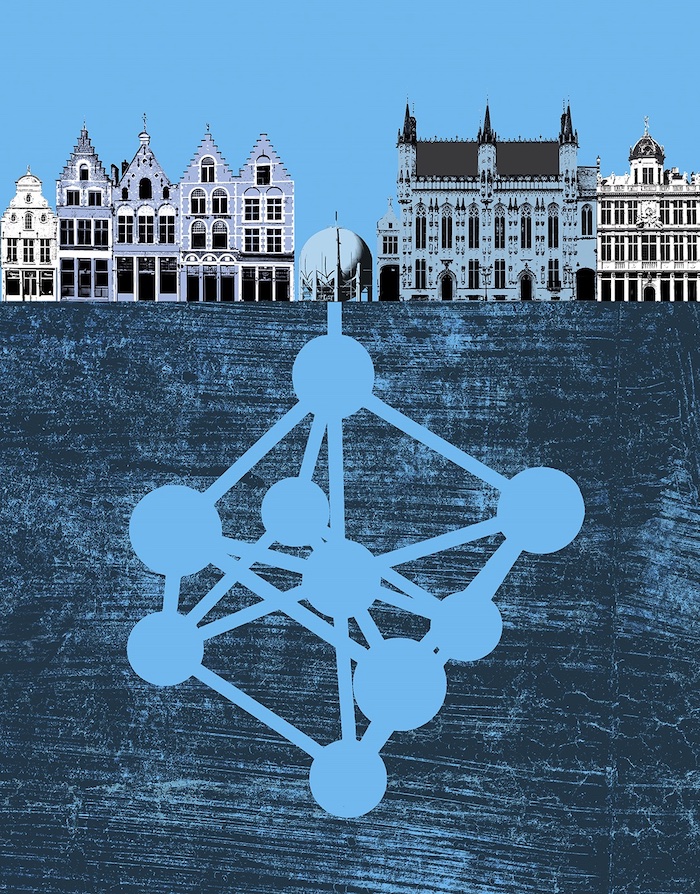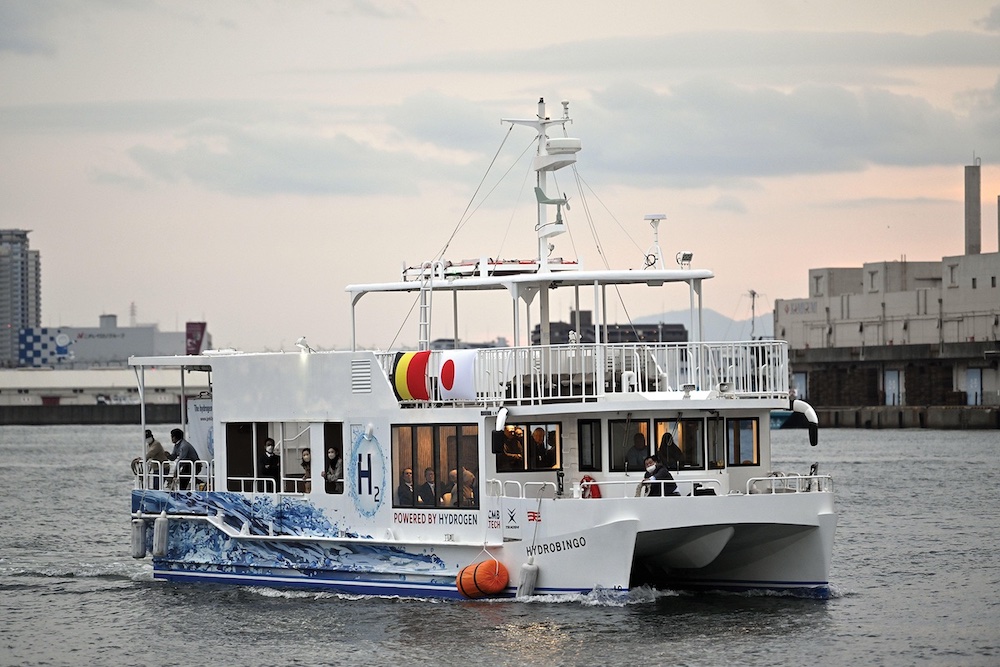CMB.TECH’s refuelling station looks like most gas stations in Belgium – all nozzles and hard, gleaming white surfaces. Except, that is, for the giant blue and red “H2” sign on the station’s undulating roof. And those nozzles aren’t distributing greenhouse gas-emitting diesel or petrol; they’re dispensing a clean-burning gas that does not warm the planet.
It is the first filling station in the world where cars, trucks, buses and ships can tank up on green hydrogen, produced onsite from water and renewable electricity. Behind the publicly accessible refuelling station is a vast site comprising several warehouses, a control room and trailers crammed with equipment.
The hydrogen refuelling station was created without any subsidies or grants following two and a half years of trial and error, and has yet to make them any money, the company’s chief technology officer (CTO) Roy Campe readily admits in an interview with The Parliament.
 Illustration by Joe Magee
Illustration by Joe Magee
But he believes low-emission ships are the future, and predicts that clients will be asking for hydrogen-powered vessels 10 years from now.
Sitting in a small waiting area next to the refuelling station, he points to framed photos of the hydrogen-powered ferry the company launched in 2021, and the hydrogen-powered tugboat it inaugurated a year later.
“We decided – let’s start small and scale up every time,” he says. The end goal? “To have a hydrogen and ammonia-powered full fleet in, let’s say, 10 years.”
CMB.TECH, owned by one of Belgium’s oldest (and wealthiest) shipping families, is one of some 100 companies and research institutions working on hydrogen applications in Belgium, a country that already has the world’s second-largest underground hydrogen pipeline network after the United States.
Belgian leaders are banking on this expertise and existing infrastructure to turn the small country into Europe’s leading import and transit hub for hydrogen.
In January, Belgium’s parliament took the first step towards adopting legislation regulating the transport of renewable hydrogen in what is believed to be a world-first law.
The government also announced the creation of an additional 100 to 160 kilometres in hydrogen transport pipelines by 2026 and promised to invest €395m to speed up the connection of the nation’s hydrogen pipeline network to Germany’s.
“Belgium has a unique story,” says Dries Van Gheluwe, a business development manager at the Port of Antwerp-Bruges. Highlighting the country’s extensive chemical cluster, its existing liquefied natural gas infrastructure and a corridor connecting the two Belgian ports with other important hubs in Europe, he says: “Belgium is the ideal playground to achieve the hydrogen transition.”
Belgium is the ideal playground to achieve the hydrogen transition
And the port of Antwerp, Europe’s second busiest, wants to play a key role in that transition.
Situated just a 15-minute drive from the CMB.TECH refuelling station is a vast, empty port site where, in a few months, construction works will begin on a green hydrogen plant, scheduled to be completed by 2025. At capacity, it will be able to produce 12,500 tonnes of green hydrogen per year.
Pointing to chimneys emitting smoke in the far distance, Lennart Verstappen, a spokesperson at the Port of Antwerp-Bruges, explains that a pipeline will transport the green hydrogen from the factory to the chemical companies based nearby, which include major players like Bayer, INEOS, BASF, Covestro and Evonik Industries.
“These companies need enormous amounts of energy, and green hydrogen is one of them,” he says. “They’ll be able to use it as a feedstock [a raw material that can be used directly as a fuel or converted to another form of fuel] in their processes.”
Green hydrogen is made from water and renewable electricity, does not emit CO2 and generates almost no air pollution, although a lot of the green energy is lost during the conversion process. Most hydrogen currently produced in Belgium and the EU, however, is grey hydrogen. Derived from methane or natural gas, grey hydrogen emits significant amounts of carbon dioxide and is mostly used to produce chemical products, such as plastics and fertilisers.
Hydrogen is expected to play a crucial role in the European Commission’s plans to reduce its greenhouse gas emissions by at least 55 per cent by 2030 and become the world’s first climate-neutral continent by 2050. To meet its ambitious climate goals, Europe will need to rapidly decarbonise every single part of its economy.
For most industries, this will mean switching to electricity gained from wind and solar farms. The magic of green hydrogen, proponents say, lies in its versatility – it can be used as feedstock, fuel or an energy carrier – and its ability to green “dirty” and hard-to-electrify sectors like steelmaking, heavy-duty transport, cement-making and aviation.
Critics, meanwhile, have pointed to the high volumes of renewable energy needed to make green hydrogen and the substantial energy losses associated with production. In their view, fossil-free hydrogen should be used exclusively in applications where electrification is unviable or too costly, and not to heat homes or fuel cars, for example.
 HydroBingo, a ferry powered by hydrogen | Photo: Alamy
HydroBingo, a ferry powered by hydrogen | Photo: Alamy
As part of RePowerEU, the European Commission’s 2022 plan to become energy independent from Russia, officials set a goal of producing 10m tonnes of renewable hydrogen and importing just as much by 2030.
They also approved €5.4bn in public funding for 41 hydrogen projects in 15 EU countries. The projects are focused on hydrogen production and fuel cells, its storage, transportation and distribution, as well as end-user applications.
The war in Ukraine made the EU executive body realise how important homegrown and imported hydrogen could be to reducing its dependence on Russian gas, explains André Wolf, an economist at the Centre for European Policy in Berlin. “They realised its potential,” he says. “But in order to achieve this, we need to step up; we need to improve regulation and promote more projects.”
With its extensive chemical cluster, Belgium – along with the Netherlands and Germany, which both also aim to become European hydrogen import and transit hubs – could serve as a model for other EU countries with heavily polluting industries, says Gerben Hieminga, an economist at ING. (In Belgium, heavy industry is responsible for nearly a third of the country’s carbon dioxide emissions.)
“The greening of manufacturing or hard-to-abate sectors by the hydrogen economy needs to go hand-in-hand with the building of hydrogen infrastructure,” Hieminga says. “Once there are good examples of how to green sectors that actually use hydrogen – so on the use case of hydrogen – those use cases can easily be exported.”
Hieminga continues: “Countries in Eastern Europe also have huge industrial clusters, and they are often more polluting than our industrial clusters on a relative basis.”
Ben McWilliams, an energy and climate policy consultant at the Brussels-based think tank Bruegel, agrees that other EU countries could indirectly benefit from the Belgian government’s hydrogen incentives. At a time when many hydrogen technologies have been proven to work, it becomes “a case of starting to deploy them and getting some incentives, so people can learn not so much new science, but ways of applying that science and doing it more efficiently”, he explains, so that, for example, steel made from green hydrogen can become cost-competitive with coal-made steel.
Drawing a parallel with solar panels in the mid- to late 2000s, he says: “You need a few years of these demonstration projects that we’re now seeing grow, and it takes a little bit of government backing to encourage this experimentation. That’s a way Belgium can in some way provide something to learn [for] the rest of Europe.”
Europe, officials have warned, will never be able to produce enough hydrogen for its needs. It’s why, under its RePowerEU plans, the Commission wants to import as much hydrogen as it plans to produce. Belgium, due to its central location in Europe’s north-western industrial belt, will be a critical piece in the European hydrogen puzzle.
The transport infrastructure for hydrogen that is going to be installed in Belgium will be critical for the rest of Europe
“Geographically, it just makes sense,” Wolf explains. “It can be something like a transit corridor or link between major industrial centres in Germany, France and the Netherlands. Therefore, the transport infrastructure for hydrogen that is going to be installed in Belgium will be critical for the rest of Europe.”
Becoming Europe’s main hydrogen import and transit hub will, however, require a lot of R&D money, much more than the €400m Belgian leaders have promised to inject. It’s why hydrogen proponents in Belgium are calling for more EU subsidies for national hydrogen projects.
“The financial support, in our view, should come from Europe as much as possible, so we can fight with the same weapons compared to our neighbouring countries,” says Isabel François, a project manager at WaterstofNet, a hydrogen knowledge and collaboration platform based in Belgium.
She warns that the European Commission’s recent decision to relax state aid rules for hydrogen and other renewable energy projects in response to the US Inflation Reduction Act would further disadvantage Belgium compared to larger countries with deeper pockets like Germany and France. “The more [funding] goes through Member States, the worse off we are,” she says.
Belgium’s complex state structure could be another obstacle to the country’s hydrogen ambitions – something local lawmakers have acknowledged. While the country’s federal government is responsible for setting hydrogen safety norms and the regulation of hydrogen transports, its regional governments oversee local ports and would be responsible for any future transports of hydrogen by inland ships.
“We need to pull in the same direction and not debate between ourselves too much as [a country] about competencies, but just take the steps ahead,” concludes François.
Belgian companies already working on hydrogen applications like CMB.TECH agree there is no time to waste. When asked what advice he would give companies with hydrogen aspirations in other EU countries, the company’s CTO doesn’t hesitate. “If you want to win the race, you have to get going,” Campe says. “Start doing something today – even if it is small, even if it is very difficult to immediately switch your entire fleet to [hydrogen]. You need to start somewhere to start accruing that knowledge.”